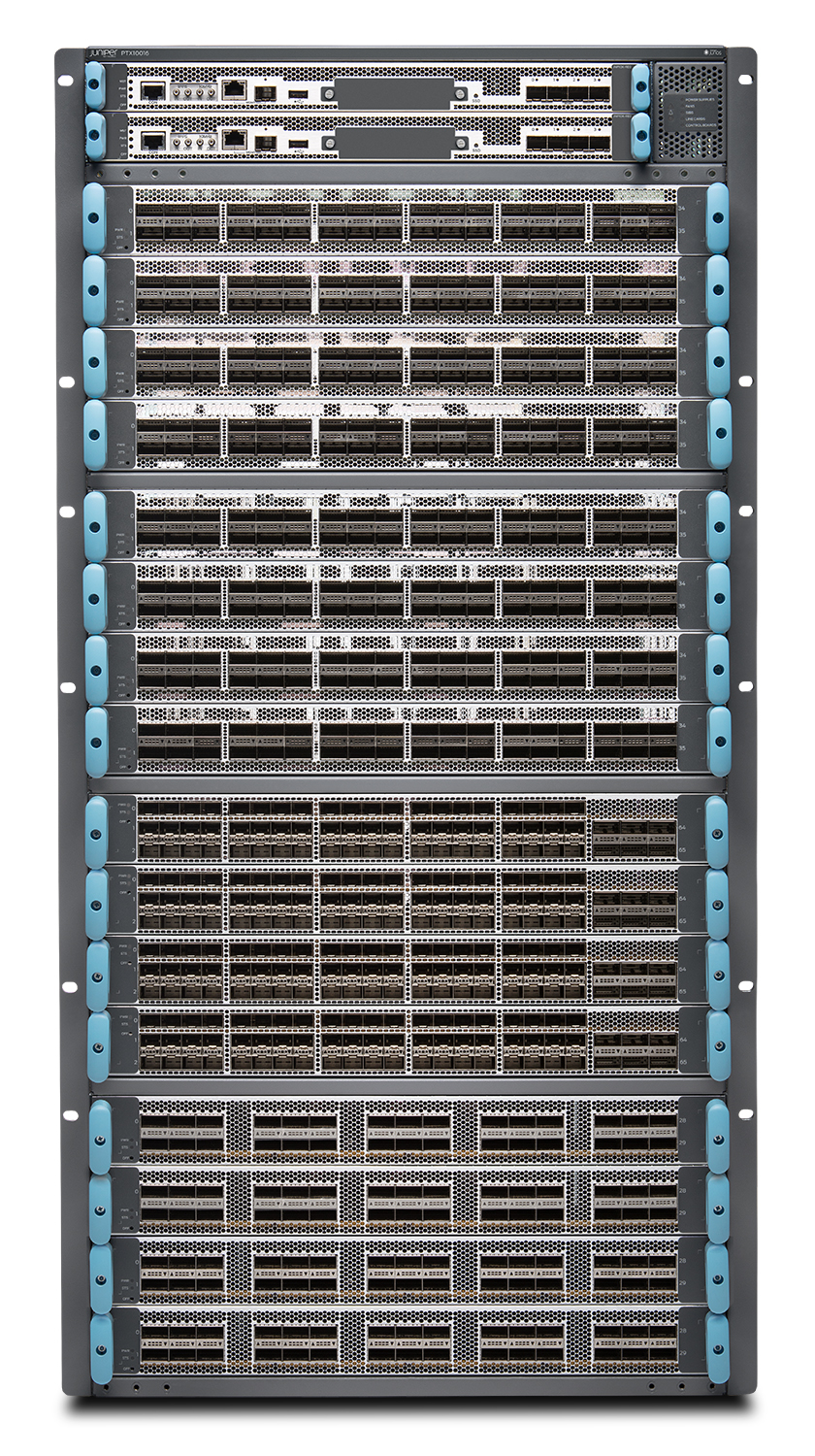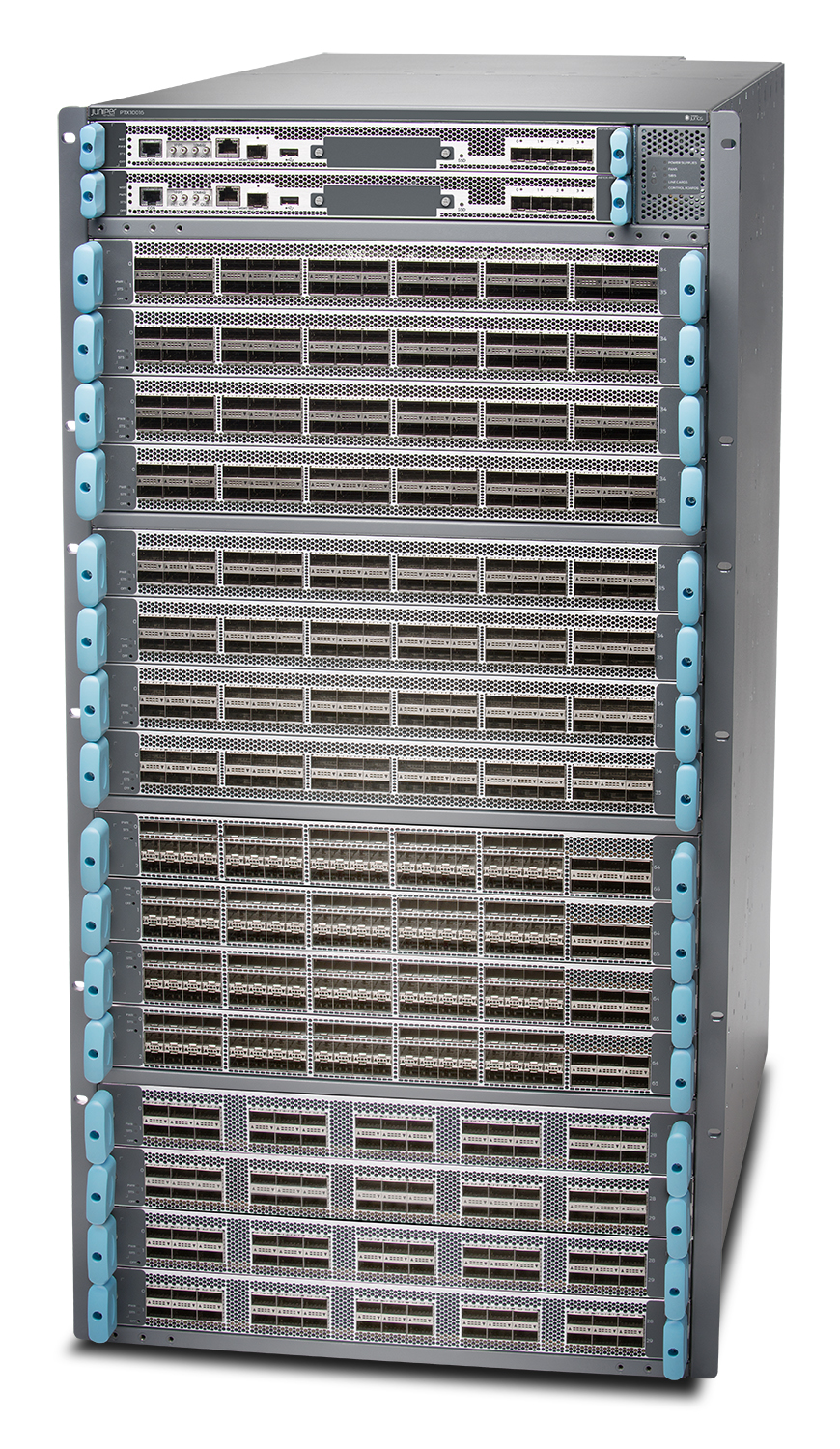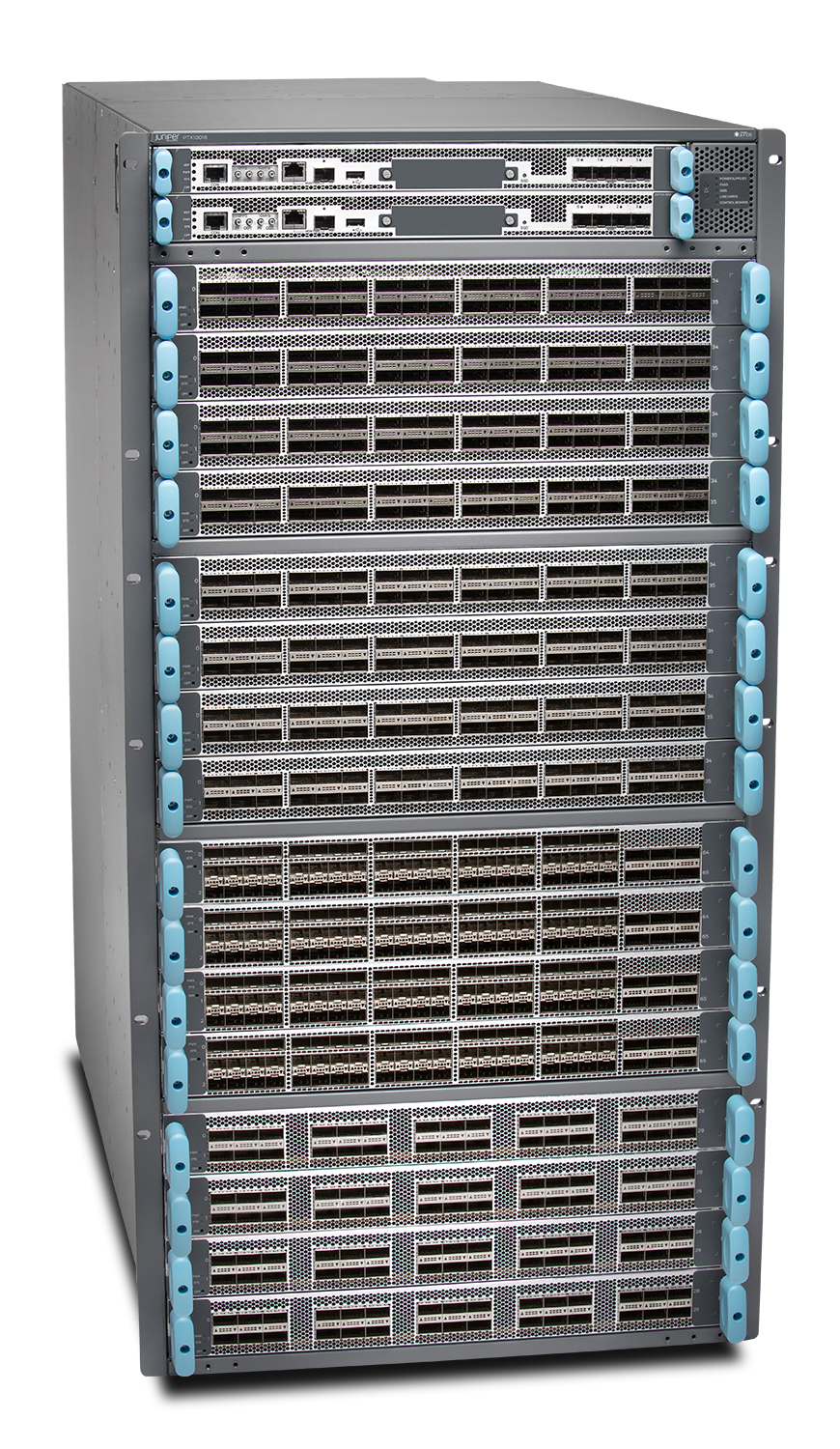
Juniper Networks PTX10016
Modular core routers optimized for next-generation data centers and collocation providers.
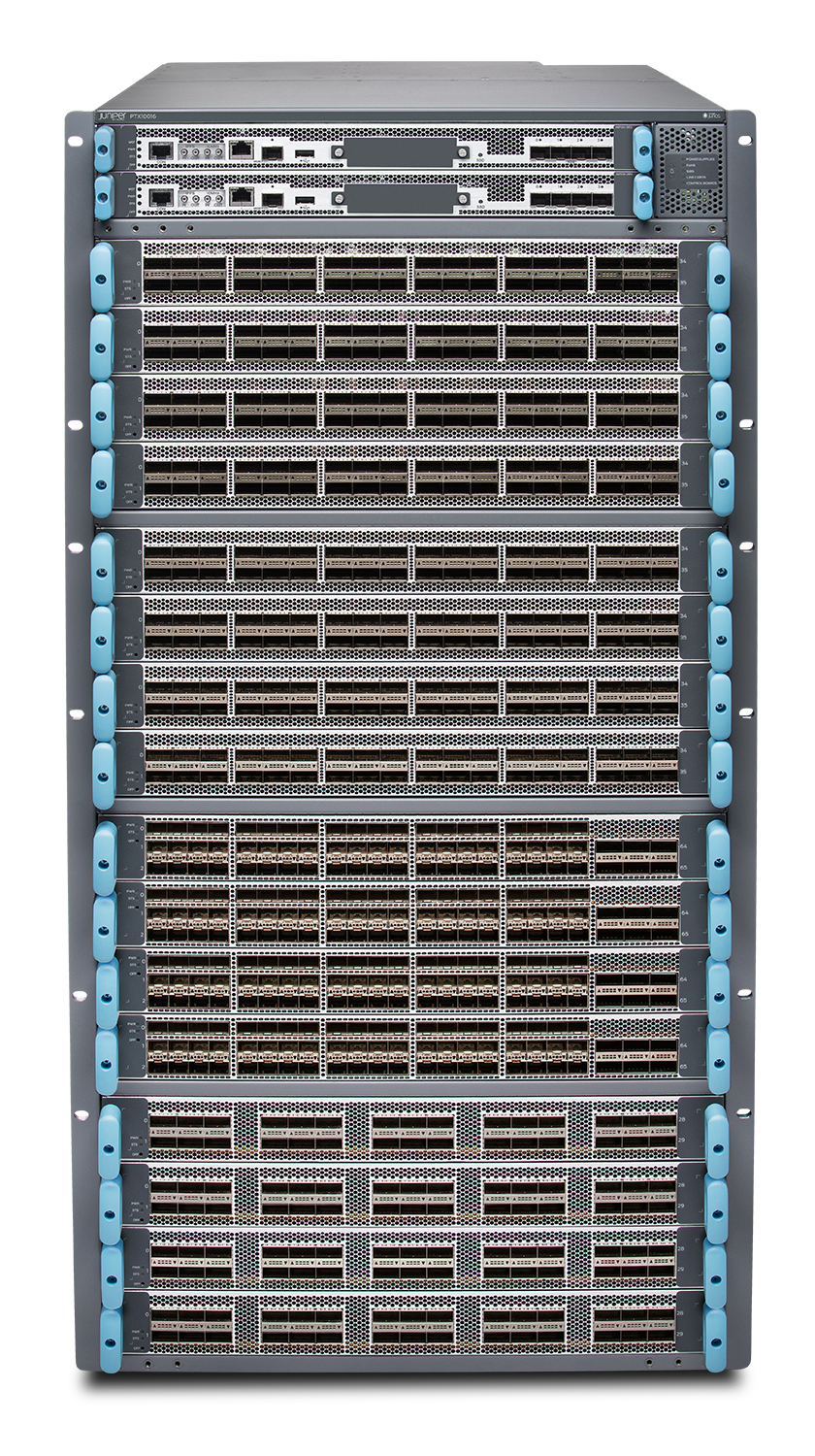
Click here to jump to more pricing!
Please Note: All prices displayed are Ex-VAT. 20% VAT is added during the checkout process.
Overview:
Networks are facing exponential data growth and changing traffic patterns as cloud, 5G, and AI become more prominent. Internet exchange providers, collocation facilities, and service providers of all types seek platforms that can flexibly scale up and scale out efficiently, securely, and at a low cost per bit. The PTX10004, PTX10008, and PTX10016 are next-generation modular routers that are leading the 400G transition with new architectures and high-performance networking silicon. These modular platforms share a common set of components and full feature sets, with various 400GbE-capable line cards available to satisfy specific core, peering, data center, and metro-core deployments in the most demanding environments.
Product Description
Network traffic today is predominately cloud access, mobile, and video applications. Data center and network operators must provide connectivity services that are low latency, low delay, and with video, provide consistent packet delay variation. The pace of application change, and the speed at which devices can process data, mean operators must be able to upgrade quickly as needs arise. Operators must have the flexibility to offer new services, adjust performance, or explore new opportunities quickly, with confidence that the new services will have sufficient capacity to sustain exponential growth.
Competing with the ability to rapidly expand capacity is the need to reduce operational costs. Providers are under enormous pressure to lower margins and compete with new entrants and disruptors that do not have legacy networks to maintain. Among the challenges they face:
- Scale: Providers may offer backbone connectivity that requires a large number of label-switched paths (LSPs). If they are using Segment Routing or RSVP to take advantage of the traffic engineering (SR-TE/RSVP-TE) functionality, the control plane signaling path must be able to scale in step with the growth of LSPs. This ability to scale is needed for both the primary and backup paths to support redundancy mechanisms like fast re-route (FRR). Today, the total number needed for backbone connectivity is a few million. This type of scaling challenge will be felt by operators who are trying to diversify their portfolios by adding a broader scope of connectivity options; for example, a data center operator who wants to provide cloud connectivity or VPN services to enterprise customers, or an operator of private line service who wants to add a collocation service to its offering.
- Operational Flexibility: Virtualized services and the explosion of cloud-based applications are creating increasingly erratic traffic patterns. To handle this unpredictability, service providers need architectures that are flexible and dynamic across all layers. A rigid architecture prevents programmable, predictable, and traffic-optimized networks from supporting any service, anywhere.
- Power Consumption: Power consumption is a variable cost. Hyperscale cloud and service providers have done much to improve the power efficiency of their applications and server operations. Multitenant data centers, collocation facilities, and service providers do not necessarily have the same ability to control all aspects of IT infrastructure and application design to dictate power utilization. Providers need systems designed to take advantage of advances in power usage improvements made in data center computing. Power efficiency is a key factor in reducing TCO.
- Space Constraints: Service providers can’t grow their physical plants forever. They need innovations like a low-touch deployment model optimized around space availability, facility power requirements, and floor weight thresholds. Efficiently scaling capacity in a small footprint is critical.
- Security: Distributed Denial of Service (DDoS) attacks are a significant part of today's threat landscape, and it is no longer feasible for providers to address this problem with traditional out-of-band scrubbing centers and manual intervention. Instead, they need a new real-time defense against volumetric DDoS attacks that delivers line-rate detection and mitigation while reducing costs. Juniper Connected Security is key to a reliable, predictable network.
In order to address these challenges, network operators need a router that delivers scale, operational efficiency, and SDN programmability. Juniper Networks® PTX Series Routers offer the industry’s only routing solution that exceeds these requirements while easily fitting into both cloud- and service-provider networks, providing full-feature support for core, peering, data center spine, data center edge, and infrastructure edge routing (see Figure 1).
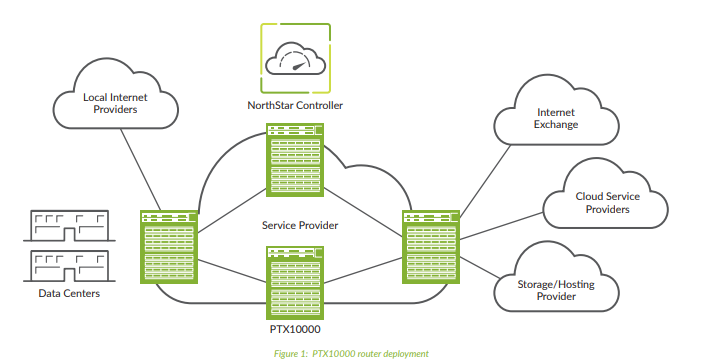
PTX10000 Modular Packet Transport Routers
The Juniper Networks PTX10000 line of Packet Transport Routers brings physical and virtual innovations to the cloud and service provider networks. These next-generation modular routers help network operators achieve their business goals while effectively handling current and future traffic demands through automation, optimization, and programmability.
PTX10004, PTX10008, and PTX10016 Modular Routers
The modular PTX10000 line features three models: the PTX10004, the PTX10008, and the PTX10016.
The PTX10004 Modular Router is the ultra-compact, ultra-high-density router for today’s space- and power-constrained facilities, supporting 400GbE architectures with inline Media Access Control Security (MACsec) on all ports for uncompromised security. The PTX10004 scales from 19.2 Tbps to 57.6 Tbps in a compact 7 U platform, design-optimized for data center and colocation racks.
Powered by Juniper’s custom Triton silicon, the PTX10004 delivers predictable IP/MPLS packet performance and functionality for multirate 100GbE/400GbE QSFP-DD. The PTX10004 is equipped with four slots, supporting from 4.8 Tbps to 14.4 Tbps per slot. A fully equipped PTX10004 with 4.8 Tbps line cards can support 192 100GbE and 16 400GbE ports. A fully equipped PTX10004 with 14.4 Tbps line cards can support 576 10GbE, 576 25GbE, 144 40GbE, 576 100GbE, or 144 400GbE ports.
The PTX10008 Modular Router is the perfect router for today’s space-constrained facilities, supporting 400GbE architectures with inline MACsec on all ports for uncompromised security. The PTX10008 offers unprecedented system capacity in a 13 U platform, scaling from 28.8 Tbps to 115.2 Tbps per standard 19-inch telecommunications rack-all at wire speed.
Powered by Juniper’s custom Triton silicon, the PTX10008 delivers predictable IP/MPLS packet performance and functionality, eliminating the complex packet profiles found in elaborate, over-engineered network processing units (NPUs) deployed in other core routers. The PTX10008 has eight slots, each supporting 4.8 Tbps to 14.4 Tbps. A fully equipped PTX10008 with 4.8 Tbps line cards can support 256 100GbE and 32 400GbE ports. A fully equipped PTX10008 with 14.4 Tbps line cards can support 1152 10GbE, 1152 25GbE, 288 40GbE, 1152 100GbE, or 288 400GbE interfaces in a single chassis.
The PTX10016 Modular Router offers ultra-high system capacity in a 21 U platform that supports 48 Tbps (96 Tbps half-duplex) per chassis, or 96 Tbps (192 Tbps half-duplex) per standard 19-inch telecommunications rack. The PTX10016 has 16 slots, each supporting 3 Tbps (6 Tbps half-duplex). A fully equipped PTX10016 can support 2304 10GbE, 576 40GbE, or 480 100GbE interfaces in a single chassis.
These modular routers enable network operators to build core architectures that optimize label-switching router (LSR), Internet backbone, peering, and optical convergence applications.
As a result, operators can-for the first time-match traffic demands with enhanced core router performance and flexible deployments. With its ultra-optimized and compact form factor, the PTX10000 line is ideal for peering, collocation, and central office locations where space and power are at a premium.
Innovations in Silicon
Innovations in silicon enable the PTX10000 line to accommodate scale-up and scale-out architectures with smooth migration paths as traffic patterns change. Juniper silicon allows adaptive load balancing, data structure sharing, and better resource utilization, all well as supporting value-added resources for additional filtering flexibility-all while lowering cost per bit.
The PTX10004 and PTX10008 are powered by the highly scalable custom Juniper Triton silicon, the industry’s first inline MACsec for 400GbE chip to support universal multirate QSFP56-DD. The Juniper Triton silicon delivers consistently low latency, 8 m counters, 256 Advanced Encryption Standard (AES) MACsec encryption supported on all ports, and wire-rate packet performance for IP traffic without sacrificing the optimized system power profile. Preserving the spirit of the Junos® Express silicon family, Juniper Triton silicon is the first purpose-built telecommunications silicon to incorporate a 3D memory architecture into the base design, offering the industry’s highest packet performance per gigabit in the fewest rack units. It also provides dynamic table memory allocation for massive IP routing scale while delivering tremendous power efficiency gains at 0.14 watts/gigabit.
The PTX10016 is powered by the highly functional Juniper Express silicon. Offering native 100GbE MACsec and 2 million+ forwarding information base, also known as forwarding table (FIB), the Express silicon family offers deep telemetry and flex packet processing, optimized for density, power, and scale with 0.4 watts/gigabit power efficiency. Express-based line cards are not compatible with Triton-based line cards.
The ability to address a provider’s core networking requirements-scale, operational flexibility, and SDN control- begins with the silicon. With the PTX10000 line, operators can now deploy a core architecture with SDN control. Combining Juniper Networks NorthStar Controller with a robust full-featured Internet backbone router, and a regional IP/MPLS core router with integrated 100GbE coherent transport for superior performance, operators can tune their network infrastructure through proactive monitoring and what-if planning capabilities. The NorthStar Controller dynamically creates explicit routing paths using a global view based on user-defined constraints to create a fully autonomous operation.
Scale is one of the guiding design principles for the PTX10000 line, allowing network operators to smoothly handle increased traffic demands. The PTX10000 line simplifies network engineering challenges with predictable system latency, improving the overall service experience by delivering best-in-class resiliency to help providers meet strict customer service-level agreements (SLAs).
SDN programmability brings virtual innovations to the service provider core, while the NorthStar Controller offers an open, standards-based solution that optimizes both the IP layer and the transport layer with precise SDN control, allowing network operators to fully automate and scale their operations with ease.
Architecture and Key Components
The PTX10000 line of Packet Transport Routers features a number of key architectural elements. Dual redundant routing engines (REs) on the PTX10004, PTX10008, and PTX10016 run the Juniper Networks Junos operating system, where they manage all routing protocol processes, router interface control, and control plane functions such as chassis component, system management, and user access to the router. These processes interact with the Packet Forwarding Engine (PFE) on the line cards via dedicated high-bandwidth management channels, providing a clean separation of the control and forwarding planes.
The PTX10000 Triton-based line cards currently support 10GbE, 25GbE, 40GbE, 100GbE, and 400GbE interfaces. The horizontal line cards in the front of the chassis connect directly to the vertical switch fabric cards in the rear of the chassis via orthogonal interconnects without requiring a midplane. This provides unparalleled investment protection by ensuring a smooth upgrade path to higher speed switch fabric cards as they become available. The midplane-less design improves airflow with a front-to-back design and enables limitless scale.
To maintain uninterrupted operation, the PTX10000 line modular chassis fan trays cool the line cards and REs with redundant, variable-speed fans. In addition, the PTX10000 line power supplies convert building power to the internal voltage required by the system. All PTX10000 line components are hot-swappable, and all central functions are available in redundant configurations, providing high operational availability by allowing continuous system operation during maintenance or repairs.
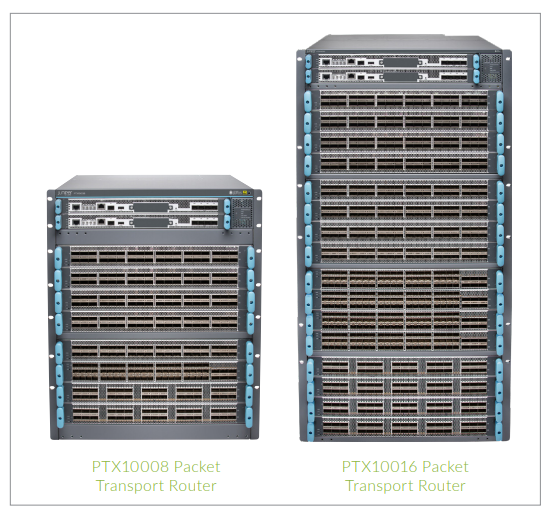
PTX10000 Hardware Components
Key hardware components of the PTX10000 line of Packet Transport Routers include the line cards, switch fabrics, and Routing Engines (REs).
Switch Fabrics
Two generations of switch fabric exist: SF and SF3. The SF fabric offers 3 Tbps capacity per slot and supports Express silicon-based line cards. The SF3 fabric enables 14.4 Tbps capacity per slot and supports Triton silicon-based line cards only.
Juniper SF and SF3 fabrics utilize purpose-built silicon to enable nonblocking communication between line cards, offering lower latency and lower delay variation to reduce power requirements and overall system costs for 100GbE deployments.
Triton Line Cards
The PTX10004 and PTX10008 routers' second-generation line card is based on the highly scalable custom Juniper Triton silicon, making it one of the industry’s leading core routers for MPLS, Internet backbone, peering, and transport integration applications. Each slot on the PTX10004 and PTX10008 can support 4.8 Tbps (9.6 Tbps half-duplex) or 14.4 Tbps (28.8 Tbps half-duplex), while the line cards support multirate 10GbE, 25GbE, 40GbE, 100GbE, and 400GbE interfaces. The line card also supports native MACsec without compromising throughput on any supported interface rate up to 400GbE, providing point-to-point security on Ethernet links. MACsec blocks security threats such as denial of service (DoS), intrusion, man-in-the-middle, masquerading, passive wiretapping, and playback attacks while securing links for most traffic frames from the Link Layer Discovery Protocol (LLDP), Link Aggregation Control Protocol (LACP), Dynamic Host Configuration Protocol (DHCP), Address Resolution Protocol (ARP), and others. All ports can support 400GbE ZR and ZR+ optics, making it ready for full packet/optical convergence without compromising density.
- PTX10K-LC1201-36CD (JNP10K-LC1201): 14.4 Tbps capacity per slot, supporting 144 10GbE, 144 25GbE, 36 40GbE, 144 100GbE, or 36 400GbE ports with QSFP56-DD/QSFP56/QSFP28-DD/QSFP28/QSFP+.
- PTX10K-LC1202-36MR (JNP10K-LC1202): 4.8 Tbps capacity per slot, supporting 32 100GbE and four 400GbE ports simultaneously with QSFP56-DD and QSFP28. Additionally, 144 10GbE, 144 25GbE, 36 40GbE are supported; 10GbE ports are also supported via breakout cables.
Express Line Cards
The PTX10016 is based on the highly capable custom Juniper Express silicon, making it one of the industry’s leading core routers for MPLS, Internet backbone, peering, and transport integration applications. Each slot on the PTX10016 supports 3 Tbps forwarding bandwidth, while the line cards support 10GbE, 40GbE, and 100GbE interfaces. Multiple Express-based interface cards are available under the PTX10016:
- PTX10K-LC1101 (JNP10K-LC1101): 3 Tbps capacity per slot supporting 96 10GbE, 30 40GbE, or 30 100GbE ports with QSFP28/QSFP+. Additionally, 10GbE ports are supported via breakout cables.
- PTX10K-LC1102 (JNP10K-LC1102): 1.4 Tbps capacity per slot supporting 144 10GbE, 36 40GbE, or 12 100GbE ports with QSFP28/QSFP+. Additionally, 10GbE ports are supported via breakout cables.
- PTX10K-LC1104 (JNP10K-LC1104): 1.2 Tbps packet optical dense wavelength-division multiplexing (DWDM) line card with MACsec supporting six 100GbE, six 150GbE, and six 200GbE ports with integrated coherent optics.
- PTX10K-LC1105 (JNP10K-LC1105): 3 Tbps capacity per slot with inline MACsec, supporting 96 10GbE, 30 40GbE, or 30 100GbE ports with QSFP28/QSFP+.
- PTX10K-LC1103 (QFX10000-60S-6Q support in PTX10K): Native 10GbE line card with 840 Gbps capacity supporting 60 1GbE, 60 10GbE, 6 40GbE, and 2 100GbE ports with QSFP28/QSFP+/SFP+.
Routing Engine
Routing Engines in the PTX10000 line perform system management and routing control functions. REs are based on the X86 architecture and can be installed in a PTX10000 line chassis to provide 1+1 redundancy. Two generations of Routing Engines exist:
- JNP10K-RE0: The first-generation RE0 Routing Engine features a quad-core 2.5 GHz Intel processor with 32 GB memory and 2x50 GB solid-state drive (SSD) storage.
- JNP10K-RE1: The second-generation RE1 Routing Engine features a core 2.2 GHz Intel processor with memory options of 64 GB or 128 GB and 2x200 GB solid-state drive (SSD) storage.
Power
The PTX10004 has three power supply slots, the PTX10008 offers six power supply slots, and the PTX10016 has 10 power supply slots, providing complete flexibility for provisioning and redundancy. Each power supply has its own internal fan for cooling. The PTX10000 line supports both AC and DC power supplies; however, AC and DC supplies cannot be mixed in the same chassis. Two generations of power supplies exist: the first generation is designed to support Express line cards, while the second generation is designed to support both Express and Triton line cards.
The first generation of AC power supplies on the PTX10000 line routers accept 200 to 240 volts alternating current (VAC) input, delivering 2700 watts of power to the chassis. The first generation of DC power supplies accept -40 to -72 volts direct current (VDC) input, delivering 2500 watts of power to the chassis. Each AC and DC power supply has two inputs for feed redundancy.
Second-generation AC power supplies (AC2) on the PTX10000 line routers are high-capacity, high-line models designed to support either AC or DC systems in either a low-power or high-power mode. The power supply takes AC input and provides DC output of 12.3 VDC, delivering 5000 watts with a single feed and 5500 watts with a dual feed. For AC systems, the operating input is 180 to 305 VAC; for DC systems, the operating input is190 to 410 VDC. Second-generation DC power supplies (DC2) provide two power supplies in a single housing that accepts either 60 A or 80 A using four redundant input power feeds.
Cooling
The PTX10000 line supports front-to-back cooling with air drawn in through the perforations on the REs and the line cards in the front of the platform. The fan trays are in front of the fabric cards and are accessible from the rear of the chassis. Hot air exhausts through the rear of the chassis.
Chassis Management
The PTX10000 line delivers powerful Junos OS chassis management that allows environmental monitoring and field-replaceable unit (FRU) control. Chassis management provides a faster primary switchover, enhanced power budgeting with a modular power management, reduced power consumption for partially populated systems, granular control over FRU power-on, adaptive cooling, and CPU leveling during monitoring intervals.
Simplified Management
The PTX10000 line routers simplify management based on the elegance and simplicity of the Junos OS. Management applications can receive streaming telemetry data to provide robust protocol analytics for an SDN environment. Junos OS enables resilience by design, operational consistency, and the versatility needed to evolve your network.
SONiC Support on the PTX10008
The PTX10008 supports Juniper’s SONiC implementation, delivering best-of-breed hardware for cloud operators while taking advantage of the flexibility of SONiC’s open and disaggregated architecture. The SONiC-enabled PTX10008 plugs seamlessly into a unified SONiC network infrastructure, leveraging the existing PTX10008 hardware. The Juniper-provided SONiC image, installed on the hardware at the factory, includes the platform device drivers and Juniper's Hardware Abstraction Layer (HAL), including Juniper's implementation of the Switch Abstraction Interface (SAI) for the Triton ASIC and the line card PFE software.
As a modular and dense multi-PFE 400GbE/100GbE platform, the PTX10008 is perfectly suited for large spine layer applications in data center IP fabrics. Juniper complements the SONiC OS with the containerized Routing Protocol Daemon (cRPD), a full-function routing and management stack packaged as a container. This ensures a consistent end-to-end routing experience across different tiers in the data center. In addition, the cRPD enables high-performance telemetry, automation, and programmability in a lightweight deployment. For features available with SONiC, please refer to the SONiC deployment guide.
PTX10008 Features and Benefits:
| Feature | Feature Description | Benefit |
|---|---|---|
| System capacity | The four-slot PTX10004 scales to 57.6 Tbps in a single chassis, supporting up to 576 10GbE, 576 25GbE, 144 40GbE, 576 100GbE, or 144 400GbE interfaces. The PTX10008 scales to 115.2 Tbps in a single chassis, supporting up to 1152 10GbE, 1152 25GbE, 288 40GbE, 1152 100GbE, or 288 400GbE interfaces. The PTX10016 has 16 slots, each supporting 3 Tbps (6 Tbps half-duplex). A fully equipped PTX10016 can support 2304 10GbE, 576 40GbE, or 480 100GbE interfaces. | The PTX10000 line gives network operators the performance and scalability needed to outpace increased traffic demands. |
| Packet performance | Groundbreaking Juniper silicon innovation powers the PTX10000 line routers with unparalleled packet processing for both full IP and MPLS functionality, thereby leveraging revolutionary 3D memory architecture. | Exceptional packet processing capabilities help alleviate the challenge of scaling the network as traffic increases while optimizing IP/MPLS transit functionality around superior performance and elegant deployability. |
| Full-scale IP and MPLS routing | The PTX10000 line of routers features a rich set of IP/MPLS services, consistent low latency, and wire-rate forwarding at scale while providing the reliability needed to meet strict SLAs. | Supports peering applications with more than 2 million IPv4 routes and 30 million routing information base (RIB) routing tables, 3000 OSPF adjacencies, and 4000 BGP sessions required to match expanding traffic demands. |
| Source Packet Routing in Networking (SPRING) | Junos OS supports Segment Routing, which provides the ability for a trusted source node to specify a forwarding path, other than the normal shortest path, that a particular packet will traverse. | Enables traffic engineering at scale, link protection using topology-independent loop-free alternates (TI-LFA) implementation, VPN traffic steering, egress peering engineering, and path verification. |
| High availability hardware | The PTX10000 line is engineered with full hardware redundancy for cooling, power supply, REs, and switch fabric. | High availability (HA) is a critical requirement for maintaining an always-on infrastructure base to meet stringent SLAs across the core. |
| High availability software | The PTX10000 line features a resilient operating system that supports HA features such as graceful RE switchover (GRES) and nonstop active routing (NSR) for high availability. PTX Series routers support 48 ms redundancy switchover under load. | Junos OS supports HA features that allow software upgrades and changes without disrupting network traffic. |
PTX10000 Modular Chassis Specifications:
| PTX10004 | |
|---|---|
| Physical dimensions (W x H x D) | 17.4 x 12.2 x 32 in. (44.2 x 33 x 81.28 cm); 42.2 in. (107.7 cm) depth with EMI door |
| Maximum weight | 271.2 lb (116.7 kg) |
| Mounting | Front rack mount |
| Power system rating* | 200-240 VAC / 50-60 Hz -48 VDC @ 60 A |
| Typical power consumption | 10.3 kW with Triton line cards, fully loaded |
| Operating temperature** | 32° to 115° F (0° to 46° C) at sea level |
| PTX10008 | |
| Physical dimensions (W x H x D) | 17.4 x 22.55 x 32 in. (44.2 x 57.76 x 81.28 cm); 39.37 in. (100 cm) depth with EMI door |
| Maximum weight | 493 lb (223.62 kg) |
| Mounting | Front rack mount |
| Power system rating* | 200-240 VAC / 50-60 Hz -48 VDC @ 60 A |
| Typical power consumption | 17.3 kW with Triton line cards, fully loaded |
| Operating temperature | 32° to 115° F (0° to 46° C) at sea level |
| PTX10016 | |
| Physical dimensions (W x H x D) | 17.4 x 36.65 x 35 in (44.2 x 93.09 x 88.90 cm); 42.40 in (107.7 cm) depth with EMI door |
| Maximum weight | 596 lb (270 kg) |
| Mounting | Front rack mount |
| Power system rating* | 200-240 VAC / 50-60 Hz -48 VDC @ 60 A |
| Typical power consumption | 18 kW with Express line cards, fully loaded |
| Operating temperature | 32° to 115° F (0° to 46° C) at sea level |
*These numbers are power supply ratings. Actual power usage is much lower.
**Assuming a max of 14W optics if fully populated and no air filter.
Documentation:
Download the Juniper Networks PTX10000 Modular Packet Transport Routers Data Sheet (PDF).

